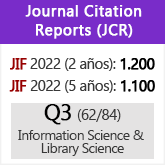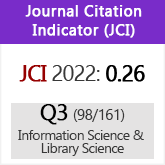Herramienta para la identificación y análisis de revistas depredadoras en ciencias biomédicas
DOI:
https://doi.org/10.3989/redc.2023.4.1445Palabras clave:
revistas depredadoras, revistas biomédicas depredadoras, investigación biomédica, biblioteca universitaria, servicios bibliotecariosResumen
Objetivo: Describir una herramienta creada desde las bibliotecas para identificar y analizar revistas depredadoras en el ámbito biomédico. Método: Se incorporan revistas potencialmente depredadoras en biomedicina, identificadas a partir de listas negras y bibliografía. De cada revista se analizan su inclusión en listas blancas, su adhesión a las asociaciones de editores, y otros datos útiles para el estudio. Resultados: Se observa un número menor de revistas presentes en las listas blancas y mayor en los directorios. El criterio más cumplido es el de adhesión a las asociaciones de editores. Discusión: Se propone una ponderación y un distinto nivel de vigilancia para las revistas. Se discute el valor de la etiqueta de depredadora cuando las fuentes no se actualizan. Conclusiones: La herramienta funciona como directorio de revistas sospechosas en biomedicina y como fuente de datos para el análisis de estas revistas. Su valor depende de su actualización.
Descargas
Citas
Abad-García, M. F. (2019). El plagio y las revistas depredadoras como amenaza a la integridad científica. Anales de Pediatría, 90(1), 57, e1-57.e8. https://doi.org/10.1016/j.anpedi.2018.11.003 PMid:30501937
Antunes, M. L., Lopes, C., y Borges, M. M. (2022). Revistas e editoras predadoras no campo da saúde. Ibersid: Revista de Sistemas de Información y Documentación, 16(2), 57-64. https://doi.org/10.54886/ibersid.v16i2.4818
AlAhmad, Y. M., Abdelhafez, I., Cyprian, F. S., Skenderi, F., Akhtar, S., & Vranic, S. (2018). A Critical Appraisal of Predatory Journals in Pathology. BioRxiv. https://doi.org/10.1101/482174
Byard, R. W. (2016). The forensic implications of predatory publishing. Forensic Science, Medicine, and Pathology, 12(4), 391-393. https://doi.org/10.1007/s12024-016-9771-3 PMid:27038941
Codina, L. (2018). Nunca publiques aquí: revistas depredadoras y cómo identificarlas. Disponible en: https://www.lluiscodina.com/revistas-depredadoras/.
COPE, Committee on Publication Ethics (2019). Discussion document: predatory publishing. Disponible en: https://www.the-scientist.com/tag/predatory-publishing.
Da Silva, J. A. T., Dobránszki, J., Al-Khatib, A., y Tsigaris, P. (2018). Challenges facing the DOAJ (Directory of Open Access Journals) as a reliable source of open access publishing venues. Journal of Educational Media and Library Sciences, 55(3).
Deora, H., Tripathi, M., Chaurasia, B., & Grotenhuis, J. A. (2021). Avoiding predatory publishing for early career neurosurgeons: what should you know before you submit? Acta Neurochirurgica, 163(1), 1-8. https://doi.org/10.1007/s00701-020-04546-9 PMid:32845360
Deprez, E., y Chen, C. (2017). Medical Journal has a fake news problem. Bloomberg Bussinessweek. Disponible en: https://www.bloomberg.com/news/features/2017-08-29/medical-journals-have-a-fake-news-problem.
Forero, D. A., Oermann, M. H., Manca, A., Deriu, F., Mendieta-Zerón, H., Dadkhah, M., Bhad, R., Deshpande, S. N., Wang, W., y Cifuentes, M. P. (2018). Negative effects of "predatory" journals on global health research. Annals of Global Health, 84(4), 584-589. https://doi.org/10.29024/aogh.2389 PMid:30779504 PMCid:PMC6748305
Greenblatt, D. J., & Bertino, J. S. (2018). Opportunistic Journals in the Clinical Pharmacology Space. The Journal of Clinical Pharmacology, 58(5), 567-571. https://doi.org/10.1002/jcph.1130 PMid:29677401
Hansoti, B., Langdorf, M., & Murphy, L. (2016). Discriminating Between Legitimate and Predatory Open Access Journals: Report from the International Federation for Emergency Medicine Research Committee. Western Journal of Emergency Medicine, 17(5), 497-507. https://doi.org/10.5811/westjem.2016.7.30328 PMid:27625710 PMCid:PMC5017830
Kakamad, F. H., Mohammed, S. H., Najar, K. A., Qadr, G. A., Ahmed, J. O., Mohammed, K. K., Salih, R. Q., Hassan, M. N., Mikael, T. M., Kakamad, S. H., et al. (2019). Kscien's list; a new strategy to hoist predatory journals and publishers. International Journal of Surgery Open, 17, 5-7. https://doi.org/10.1016/j.ijso.2019.01.002
Laine, C., y Winker, M. A. (2017). Identifying predatory or pseudo-journals. Biochemia Medica, 27(2), 285-291. DOI: https://doi.org/10.11613/BM.2017.031. https://doi.org/10.11613/BM.2017.031 PMid:28694720 PMCid:PMC5493175
Macháček, V. y Srholec M. (2022). Predatory publishing in Scopus: Evidence on cross-country differences. Quantitative Science Studies, 3 (3): 859-887. https://doi.org/10.1162/qss_a_00213
Maddy, A. J., & Tosti, A. (2017). Predatory journals in dermatology. British Journal of Dermatology, 177(1), 307-309. https://doi.org/10.1111/bjd.15072 PMid:27639036
Manca, A., Martinez, G., Cugusi, L., Dragone, D., Mercuro, G., & Deriu, F. (2017). Predatory Open Access in Rehabilitation. Archives of Physical Medicine and Rehabilitation, 98(5), 1051-1056. https://doi.org/10.1016/j.apmr.2017.01.002 PMid:28115073
Manca, A., Martinez, G., Cugusi, L., Dragone, D., Dvir, Z., y Deriu, F. (2017). The surge of predatory open-access in neurosciences and neurology. Neuroscience, 353, 166-173. https://doi.org/10.1016/j.neuroscience.2017.04.014 PMid:28433651
Matumba, L., Maulidi, F., Balehegn, M., Abay, F., Salanje, G., Dzimbiri, L., y Kaunda, E. (2019). Blacklisting or whitelisting? Journal of Scholarly Publishing, 50(2), 83-95. https://doi.org/10.3138/jsp.50.2.01
Misra, D. P., Ravindran, V., Wakhlu, A., Sharma, A., Agarwal, V., y Negi, V. S. (2017). Publishing in black and white: the relevance of listing of scientific journals. Rheumatology International, 37(11), 1773-1778. https://doi.org/10.1007/s00296-017-3830-2 PMid:28983732
Nicholson, D. R. (2018). Predatory Publishing Practices: Is There Life After Beall's List? Libres, 27(2), 53-70. https://www.libres-ejournal.info/2565/ https://doi.org/10.32655/LIBRES.2017.2.1
Patwardhan, B. (2017). Indian Science and Predatory Journals. Journal of Ayurveda and Integrative Medicine, 8(1), 1-2. https://doi.org/10.1016/j.jaim.2017.02.004 PMid:28285112 PMCid:PMC5377474
Seethapathy, G. S., Santhosh Kumar, J. U., y Hareesha, A. S. (2016). India's Scientific Publication in Predatory Journals:Need for Regulating Quality of Indian Science and Education. Current Science, 111(11), 1759. https://doi.org/10.18520/cs/v111/i11/1759-1764
Sharma, S. (2019). Does India need more medical scientists? Perspectives in Clinical Research, 10(3), 106. https://doi.org/10.4103/picr.PICR_114_18 PMid:31403027 PMCid:PMC6647902
Shen, C., y Björk, B. C. (2015). "Predatory" open access: A longitudinal study of article volumes and market characteristics. BMC Medicine, 13(1), 1-15. https://doi.org/10.1186/s12916-015-0469-2 PMid:26423063 PMCid:PMC4589914
Türp, J., & Antes, G. (2020). "Greetings for the day!" Unsolicited e-mails from questionable journals. Dtsch Zahnärztl Z Int, 2(4), 109-113.
Yan, J. R., Baldawi, H., Lex, J. R., Simchovich, G., Baisi, L.-P., Bozzo, A., y Ghert, M. (2018). Predatory Publishing in Orthopaedic Research. The Journal of Bone and Joint Surgery, 100(21), e138. https://doi.org/10.2106/JBJS.17.01569 PMid:30399085
Publicado
Cómo citar
Número
Sección
Licencia
Derechos de autor 2023 Consejo Superior de Investigaciones Científicas (CSIC)

Esta obra está bajo una licencia internacional Creative Commons Atribución 4.0.
© CSIC. Los originales publicados en las ediciones impresa y electrónica de esta Revista son propiedad del Consejo Superior de Investigaciones Científicas, siendo necesario citar la procedencia en cualquier reproducción parcial o total.Salvo indicación contraria, todos los contenidos de la edición electrónica se distribuyen bajo una licencia de uso y distribución “Creative Commons Reconocimiento 4.0 Internacional ” (CC BY 4.0). Puede consultar desde aquí la versión informativa y el texto legal de la licencia. Esta circunstancia ha de hacerse constar expresamente de esta forma cuando sea necesario.
No se autoriza el depósito en repositorios, páginas web personales o similares de cualquier otra versión distinta a la publicada por el editor.

















